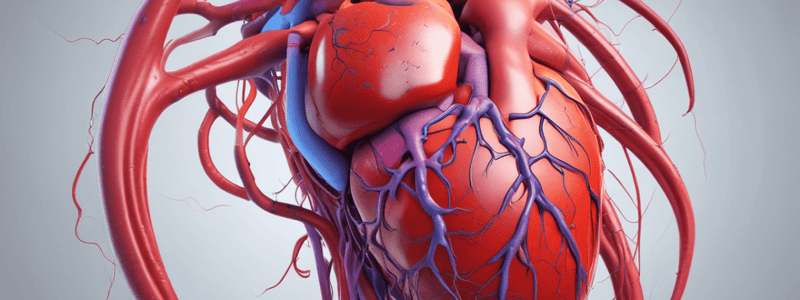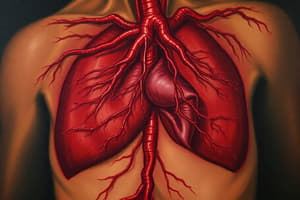Podcast
Questions and Answers
What is the most common cause of pulmonary embolism?
What is the most common cause of pulmonary embolism?
- Amniotic fluid
- Gas bubbles
- Tumor cells
- Pieces of thrombus (correct)
What is the most common origin of systemic arterial emboli?
What is the most common origin of systemic arterial emboli?
- Arterial circulation
- Unknown origin
- Intracardiac mural thrombi (correct)
- Traumatic rupture
Which of the following is NOT a common cause of tissue infarction?
Which of the following is NOT a common cause of tissue infarction?
- Toxins or trauma (correct)
- Hemorrhage into atheromatous plaque
- Vasospasm
- Thrombotic and embolic events
What is the shape of an infarct in the kidney?
What is the shape of an infarct in the kidney?
Which type of infarct is associated with infection?
Which type of infarct is associated with infection?
Which of the following is NOT a common cause of shock?
Which of the following is NOT a common cause of shock?
What is the primary symptom of shock?
What is the primary symptom of shock?
What is the main difference between acute and chronic inflammation?
What is the main difference between acute and chronic inflammation?
What is the main purpose of the inflammatory response?
What is the main purpose of the inflammatory response?
Which of the following is NOT a common source of emboli?
Which of the following is NOT a common source of emboli?
What is the MAIN difference between acute and chronic inflammation?
What is the MAIN difference between acute and chronic inflammation?
What is the MAIN function of macrophages in chronic inflammation?
What is the MAIN function of macrophages in chronic inflammation?
What is the MAIN purpose of granuloma formation in chronic inflammation?
What is the MAIN purpose of granuloma formation in chronic inflammation?
Which of the following is the MOST characteristic feature of chronic inflammation?
Which of the following is the MOST characteristic feature of chronic inflammation?
What is the MAIN reason for the development of granulomas in chronic inflammation?
What is the MAIN reason for the development of granulomas in chronic inflammation?
Which of the following is the MOST important cell type involved in the pathogenesis of chronic inflammation?
Which of the following is the MOST important cell type involved in the pathogenesis of chronic inflammation?
What is the MAIN reason for the development of systemic effects like fever and weight loss in chronic inflammation?
What is the MAIN reason for the development of systemic effects like fever and weight loss in chronic inflammation?
What is the MAIN reason why fibrosis is an irreversible outcome of chronic inflammation?
What is the MAIN reason why fibrosis is an irreversible outcome of chronic inflammation?
Which of the following is the MOST common cause of chronic inflammation?
Which of the following is the MOST common cause of chronic inflammation?
What is the MAIN difference between caseating and non-caseating granulomas in chronic inflammation?
What is the MAIN difference between caseating and non-caseating granulomas in chronic inflammation?
Which of the following is NOT one of the four cardinal signs of inflammation?
Which of the following is NOT one of the four cardinal signs of inflammation?
What is the primary function of the inflammatory response?
What is the primary function of the inflammatory response?
Which of the following mediators is NOT involved in causing vasodilation during the inflammatory response?
Which of the following mediators is NOT involved in causing vasodilation during the inflammatory response?
Which of the following is NOT a mechanism by which increased vascular permeability occurs during inflammation?
Which of the following is NOT a mechanism by which increased vascular permeability occurs during inflammation?
What is the process by which leukocytes migrate from the blood vessel lumen to the interstitial tissue called?
What is the process by which leukocytes migrate from the blood vessel lumen to the interstitial tissue called?
Which of the following is NOT a receptor involved in leukocyte recognition of pathogens or inflammatory signals?
Which of the following is NOT a receptor involved in leukocyte recognition of pathogens or inflammatory signals?
What is the term used to describe the process by which phagocytes engulf and destroy pathogens or foreign particles?
What is the term used to describe the process by which phagocytes engulf and destroy pathogens or foreign particles?
Which of the following is NOT a morphological pattern of acute inflammation?
Which of the following is NOT a morphological pattern of acute inflammation?
What is the term used to describe the process by which leukocytes are attracted to the site of injury by chemotactic agents?
What is the term used to describe the process by which leukocytes are attracted to the site of injury by chemotactic agents?
Which of the following is NOT a possible outcome of acute inflammation?
Which of the following is NOT a possible outcome of acute inflammation?




